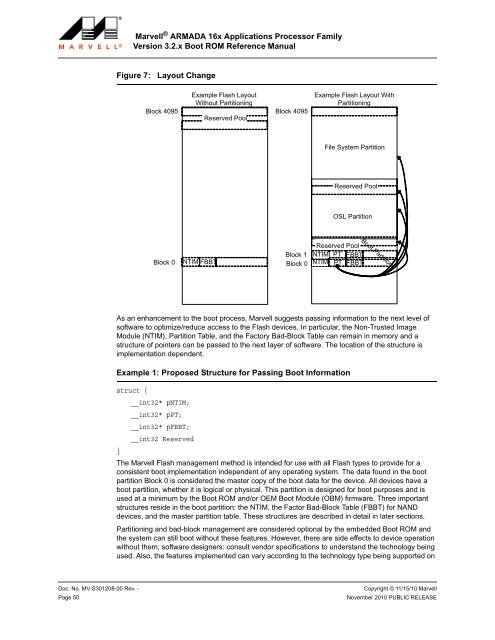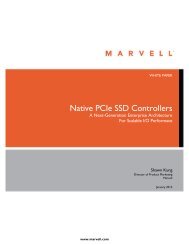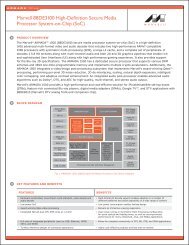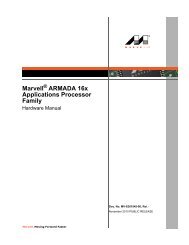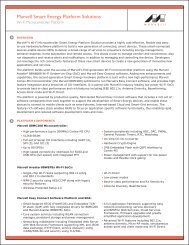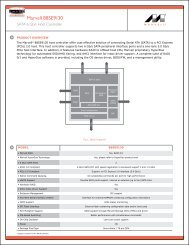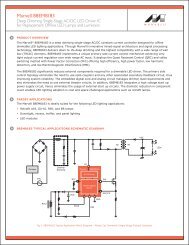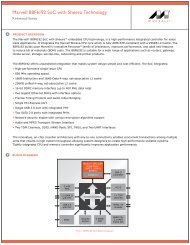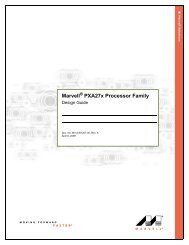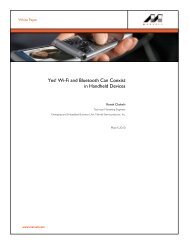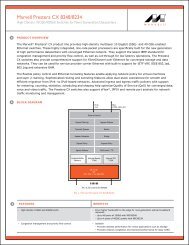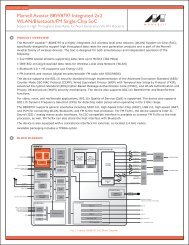Marvell ARMADA 16x Applications Processor Family
7 Marvell ® ARMADA 16x Applications Processor Family ...
7 Marvell ® ARMADA 16x Applications Processor Family ...
- No tags were found...
Create successful ePaper yourself
Turn your PDF publications into a flip-book with our unique Google optimized e-Paper software.
<strong>Marvell</strong> ® <strong>ARMADA</strong> <strong>16x</strong> <strong>Applications</strong> <strong>Processor</strong> <strong>Family</strong><br />
Version 3.2.x Boot ROM Reference Manual<br />
Figure 7:<br />
Layout Change<br />
Block 4095<br />
Block 0<br />
Example Flash Layout<br />
Without Partitioning<br />
NTIM<br />
FBBT<br />
Reserved Pool<br />
Block 4095<br />
Block 1<br />
Block 0<br />
As an enhancement to the boot process, <strong>Marvell</strong> suggests passing information to the next level of<br />
software to optimize/reduce access to the Flash devices. In particular, the Non-Trusted Image<br />
Module (NTIM), Partition Table, and the Factory Bad-Block Table can remain in memory and a<br />
structure of pointers can be passed to the next layer of software. The location of the structure is<br />
implementation dependent.<br />
Example 1: Proposed Structure for Passing Boot Information<br />
Example Flash Layout With<br />
Partitioning<br />
File System Partition<br />
Reserved Pool<br />
OSL Partition<br />
Reserved Pool<br />
NTIM<br />
PT FBBT<br />
NTIM<br />
PT FBBT<br />
Boot Partition<br />
struct {<br />
__int32* pNTIM;<br />
__int32* pPT;<br />
__int32* pFBBT;<br />
__int32 Reserved<br />
}<br />
The <strong>Marvell</strong> Flash management method is intended for use with all Flash types to provide for a<br />
consistent boot implementation independent of any operating system. The data found in the boot<br />
partition Block 0 is considered the master copy of the boot data for the device. All devices have a<br />
boot partition, whether it is logical or physical. This partition is designed for boot purposes and is<br />
used at a minimum by the Boot ROM and/or OEM Boot Module (OBM) firmware. Three important<br />
structures reside in the boot partition: the NTIM, the Factor Bad-Block Table (FBBT) for NAND<br />
devices, and the master partition table. These structures are described in detail in later sections.<br />
Partitioning and bad-block management are considered optional by the embedded Boot ROM and<br />
the system can still boot without these features. However, there are side effects to device operation<br />
without them; software designers: consult vendor specifications to understand the technology being<br />
used. Also, the features implemented can vary according to the technology type being supported on<br />
1<br />
2<br />
3<br />
4<br />
5<br />
6<br />
7<br />
8<br />
9<br />
10<br />
11<br />
12<br />
13<br />
14<br />
15<br />
16<br />
17<br />
18<br />
19<br />
20<br />
21<br />
22<br />
23<br />
24<br />
25<br />
26<br />
27<br />
28<br />
29<br />
30<br />
31<br />
32<br />
33<br />
34<br />
35<br />
36<br />
37<br />
38<br />
39<br />
40<br />
41<br />
42<br />
43<br />
44<br />
45<br />
46<br />
47<br />
48<br />
49<br />
50<br />
51<br />
52<br />
53<br />
54<br />
55<br />
56<br />
57<br />
58<br />
Doc. No. MV-S301208-00 Rev. - Copyright © 11/15/10 <strong>Marvell</strong><br />
Page 50<br />
November 2010 PUBLIC RELEASE


